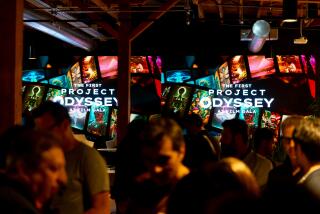Computer Graphics Go Glitzy : Show Business Projects Among Big Winners at High-Tech Competition
- Share via
It was a night much like Oscar night--with showings of the winning films, nervous acceptance speeches that included naming the “little people” and, afterward, even some autograph seekers. The glitzy awards ceremony Tuesday, part of the National Computer Graphics Assn.’s annual conference and exhibition in Anaheim this week, was proof that at least a segment of the computer industry has gone Hollywood.
That’s only fitting, of course, because parts of Hollywood already have gone computer.
Among the winners in the association’s International Computer Animation Competition were a rock video for Mick Jagger of the Rolling Stones and the logo for CBS’ Tuesday movie show. The dinner audience was teased with clips from another two feature-length films using computer-generated graphics.
The marriage of computer-generated graphics and movie making has brought benefits to both partners. For the film makers, computers offer relatively fast and inexpensive methods for doing things that are impossible, or next-to-impossible, to stage in real life.
For instance, one of the acknowledged stars of the computer-generated animation field, Digital Productions, showed a titles segment that it created for “Labyrinth,” a yet-to-be-released George Lucas-Jim Henson film. The segment shows an owl gracefully soaring in and out while the credits are displayed. One of the segment’s creators said that Henson had unsuccessfully tried first to film a live owl and then to create a Muppet-like bird before turning to the Los Angeles company for a computer-generated owl.
For computer graphics companies, the Hollywood connection adds glamour and draws attention to what otherwise is a very serious-minded segment of the high-technology industry.
The graphics trade group estimates that animation accounts for only 1% of total 1985 sales of $7.35 billion in major applications of computer graphics. Projections say that as the industry as a whole grows at a 30% clip through the next five years, animation’s share will double.
‘Gee-Whiz’ Caliber
Industry experts say a primary force in the industry will be the technology that enables sophisticated graphics to be done on personal computers. Until now, the primary markets for graphics have been in computer-aided design, manufacturing and engineering--segments that use more powerful and costly computer workstations. The graphics now being produced in those areas, however, are no less of a “gee-whiz” caliber than the animated films and commercials.
Many of the companies exhibiting this week at the Anaheim Convention Center show how their machines and software can generate astonishingly complex, and yet beautiful, displays that simulate machines, environments and real-time interactions.
Crowds of conference attendees continually jammed the Evans & Sutherland booth to watch demonstrations. The Salt Lake City-based company’s specialized computer hardware and software are used, for instance, in aerospace and military simulations and in medical imaging.
Another popular stop on the exhibit route was Pixar, a company with celebrity status of its own. Formerly a part of Industrial Light & Magic, the special-effects arm of Lucasfilm Ltd., Pixar recently was spun off, with former Apple Computer chief Steven P. Jobs buying the majority interest.
But Pixar officials recognize that movies are only a small fraction of the market for graphics and have been working to shed the movie image as it moves into more lucrative scientific markets for its high-priced image-generating computers.
Increase in Revenue
Abel Image Research, the graphics unit of Hollywood-based Abel & Associates, took the contest’s “best of show” with a series of subtly elegant computer-generated commercials.
But it, too, is looking to be a serious player in the graphics market. Its revenue increased more than fivefold after it began selling the software that it developed for its commercial graphics to companies like McDonnell Douglas and BMW.
“People want images and they want them quickly,” said Robert Abel, the privately held company’s founder and president. Computer graphics, he said, “take what’s going on in people’s heads and give it a visible form.”
WHERE COMPUTER GRAPHICS ARE USED
Sales (billions Application area of dollars) Computer-aided mechanical design and manufacturing 2.31 Computer-aided electronic design and engineering 1.02 Business graphics 1.30 Image processing 0.95 Electronic publishing 0.72 Architecture/engineering/construction 0.72 Mapping/cartography 0.22 Animation 0.11
Market Share Application area (percent) Computer-aided mechanical design and manufacturing 31 Computer-aided electronic design and engineering 14 Business graphics 18 Image processing 13 Electronic publishing 10 Architecture/engineering/construction 10 Mapping/cartography 3 Animation 1
Source: National Computer Graphics Assn.






